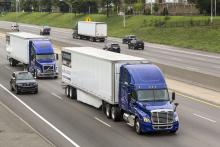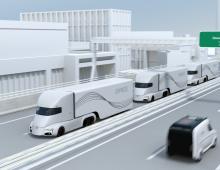NXP Semiconductors is setting the pace in truck platooning with full-size commercial vehicles that can run at 80kmph only 11 metres apart, offering up to 11 per cent in fuel savings. The Dutch technology company believes that “there’s no better place than truck platooning to demonstrate the merits of autonomous driving.”
Its research team has been working with DAF Trucks to develop leading edge technology that can make driving decisions ‘30 times faster than human reaction time’.
NXP says that adapt
Its research team has been working with
NXP says that adaptive cruise control, vehicle-to-vehicle communication systems and enhanced radar are some of the essential building blocks that allow truck platooning and the company already has in place a system that it claims allows two or more trucks to electronically couple together so that accelerating and braking by the lead truck is relayed instantaneously to following trucks, guiding their actions.
The end “result is closer following distances between trucks, with significant increases in fuel efficiency and safety,” says NXP. And, at the European Truck Platooning Challenge held earlier this year, NXP, DAF Trucks, TNO and Ricardo achieved a breakthrough, platooning trucks only 0.5 seconds apart.
Running a line of trucks close together reduces the amount of air turbulence and drag faced by each truck. According to NXP, in a five-truck platoon the fuel savings compute to two per cent for the lead truck, 11 per cent for the middle truck, and nine per cent for the last two trucks”.
The NXP, DAF Trucks,
The next generation S32R27 radar will play an important role in the future ability of a vehicle to quickly make precise, safety-related decisions. Autonomous vehicles will need to accurately detect and classify objects says NXP and it believes the NXP S32R27 Radar MCU offers a leap in performance of four times over the previous MPC577X product. NXP says this means higher accuracy and safety for applications such as collision avoidance, lane change assist, autonomous emergency braking, radar cocooning with 360-degree vision or adaptive cruise control. In intelligent transport systems, vulnerable road users like pedestrians, motorcycles and bicycles can be detected and tracked much faster.
Running a flotilla of trucks along the highway like a line of railway carriages could mean big labour savings for haulage operators too, says Jack Martens, project manager advanced technology at DAF Trucks. If the driver of the leading vehicle is considered as the only driver “working”, perhaps the drivers in the following trucks could be considered at rest and be allowed to have their tachographs switched off.
These sorts of benefit would need legal interpretation however, says Martens, who was also keen to point out that, for the time being, DAF will only experiment with two-truck platoons. DAF is worried about the anti-social implications of running long truck convoys on roads where the public has not been prepared for such things, and where run-in lanes could be blocked as the platoon passes by.
“What we’re really looking at is self-driving robots on wheels,” adds Kurt Sievers, general manager NXP Automotive, “and, through a combination of different sensors, we will soon see robot vehicles on the road that can see their environment faster than, more reliably than and more accurately than a human being. Connect the vehicle to things like traffic lights and the traffic infrastructure around it, give it the ability to see round corners, give it high precision digital maps and AI (artificial intelligence) … and we can start to replace the human being.”
Two strands of development are also emerging. The car and truck manufacturers are following an evolutionary path, adding self-driving technology to their product offerings bit by bit. The revolutionaries, like Google, apple and uber have gone straight there without the baggage of vast manufacturing plants and dealership networks. “For the first group it is all about the vehicle,” says Sievers, “and for the second group, it is all about the service. NXP supports both of them.”







